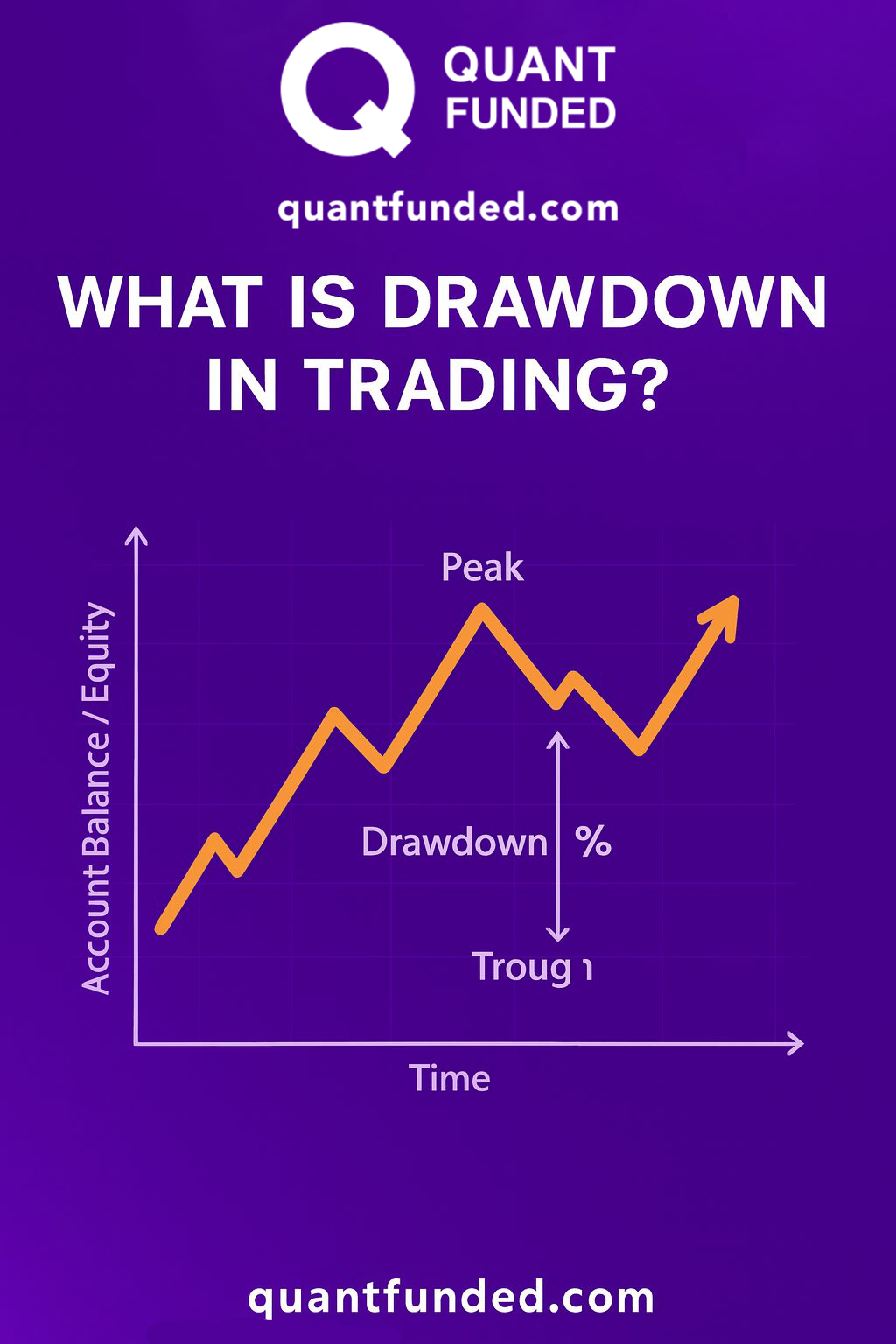Why Drawdown Defines a Trader’s Success
In trading, making profits is only half the story. The other half—and arguably the most important—is how well you manage losses. Every trader faces losing streaks, but the difference between amateurs and professionals lies in how they handle drawdown.
At Quant Funded, discipline and risk control are the foundation of success. Understanding drawdown is not only essential for passing evaluations but also for building a long-term career as a funded trader. In this guide, we’ll explain what drawdown is, its types, why it matters, and strategies to manage it effectively.
What Is Drawdown in Trading?
Definition and Core Concept
Drawdown measures how much a trading account has fallen from its highest point (peak) before recovering. It’s expressed as a percentage and tells traders the depth of losses during downturns.
How Drawdown Is Calculated
To calculate drawdown:
-
Identify the account’s peak balance or equity.
-
Subtract the lowest point (trough) reached after that peak.
-
Divide the difference by the peak, then multiply by 100 to get the percentage.
Examples of Drawdown in Real Trading Accounts
-
If an account grows from $10,000 → $12,000 → drops to $11,000, the drawdown is 8.33%.
-
If it later climbs above $12,000, that drawdown is “closed.”
Put simply: drawdown shows how much your account went down before bouncing back up.


Types of Drawdown Every Trader Must Know
Absolute Drawdown
The difference between the starting balance and the lowest point below it.
- Example: Starting with $10,000 and falling to $9,500 equals a $500 drawdown.
Maximum Drawdown
The single largest loss from a peak to a trough across the entire trading history.
- Example: $15,000 peak falling to $12,000 = $3,000 max drawdown.
Relative (Percentage) Drawdown
The percentage decline from a peak balance or equity.
- Example: A drop from $10,000 to $9,200 = 8% relative drawdown.
Key Differences Between the Three
-
Absolute: Focuses on capital safety.
-
Maximum: Shows the worst-case loss.
-
Relative: Reflects risk-adjusted performance.

Why Drawdown Matters for Quant Funded Traders
Protecting Capital from Irrecoverable Losses Drawdown control ensures traders don’t blow up accounts. At Quant Funded, keeping losses small means staying in the game longer.
The Psychological Impact of Large Drawdowns
A trader facing a 30% drawdown often experiences stress, panic, and poor decision-making. The emotional weight can break discipline faster than the losses themselves.
The Mathematics of Recovery After Losses The deeper the drawdown, the harder recovery becomes:
10% loss → needs 11% gain to recover.
50% loss → needs 100% gain to recover.
This compounding effect proves why controlling drawdowns is crucial.
Drawdown and Proprietary Trading Firm Rules
Daily Drawdown Limits
Prevent traders from blowing accounts in one bad session.
Overall Maximum Drawdown Limits
Keep total losses within sustainable ranges.
Equity vs. Balance Tracking in Prop Firms
Some firms track only closed trades (balance), while others include floating losses (equity). At Quant Funded, both are monitored for accuracy.
Quant Funded’s Approach to Risk Management
By setting strict rules, Quant Funded ensures only disciplined traders who respect risk management can qualify for long-term funding.
Effective Strategies to Manage Drawdown
Proper Position Sizing
Risk no more than 1–2% per trade. Even after 10 losses, your account remains safe.
Using Stop Losses Effectively
Always use stop losses. Trading without them is one of the fastest ways to fail at Quant Funded.
Diversifying Across Assets
Avoid concentrating risk in a single market. Spread trades across assets for stability.
Avoiding Revenge Trading
Doubling down to chase losses often leads to explosive drawdowns. Step away after reaching daily limits.
Monitoring Equity in Real Time
Balance doesn’t tell the full story. Monitoring equity helps track true account health.
Setting Personal Risk Limits Below Firm Rules
If the firm’s maximum is 10%, set your own at 7–8%. This buffer keeps you safe.
The Psychology of Drawdown: Mindset Over Markets
Fear, Greed, and Frustration Cycles
Fear stops traders from executing good trades. Greed pushes them into oversized risks. Frustration makes them abandon proven strategies.
Building Emotional Resilience
Stay calm during losing streaks. Journaling, meditation, and consistent routines help reduce emotional stress.
Developing a Professional Trader’s Mindset
Professionals accept drawdowns as part of the process. They focus on managing risk, not chasing losses.
Realistic Expectations About Drawdowns
Comparing Consistent vs. Aggressive Traders
-
Consistent traders: 2–4% monthly profits, drawdowns under 5%.
-
Aggressive traders: 15–20% monthly goals, drawdowns up to 20% (unsustainable).
Lessons from Professional Hedge Funds
Even the best hedge funds endure drawdowns, but they survive by managing them.
What Quant Funded Rewards in Its Traders
Discipline, consistency, and capital protection—not gambling for big gains.
Frequently Asked Questions (FAQs)
1.What is considered a healthy drawdown? Generally, 5–9% is considered safe for professional traders.
2.How does Quant Funded calculate drawdown? We use an equity-based drawdown, tracking both closed and floating losses.
- Can you recover from a large drawdown? Yes, but recovery is harder. A 50% loss requires 100% gain to break even.
- What is the difference between equity and balance drawdown?
-
Balance drawdown: Closed trades only.
-
Equity drawdown: Includes open trades and floating losses.
- How much should I risk per trade to control drawdown? Most professionals recommend 1–2% per trade.
- Do professional traders also face drawdowns?
Absolutely. Every trader experiences them—what matters is how you manage them.
Mastering Drawdown to Succeed as a Quant Funded Trader
Drawdown isn’t just about numbers—it’s about discipline, resilience, and professional risk management. At Quant Funded, success isn’t defined by how much you win, but by how well you protect your capital when markets turn against you.
By controlling position size, respecting stop losses, and maintaining a calm mindset, you can minimize drawdowns and maximize long-term survival. Remember: profits come and go, but managing drawdown keeps you in the game.
